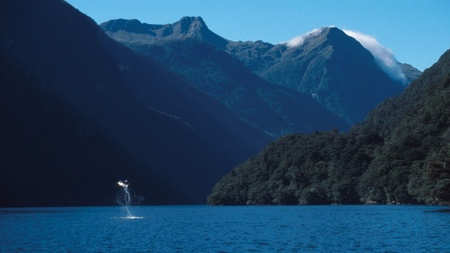A team of dolphin experts from Scotland have shed new light on the effect of marine tourism on the behaviour of dolphins.
The team examined the impact of tour boats on the foraging efficiency of an endangered population of bottlenose dolphins off the coast of New Zealand. Their findings, published online in the Journal of Applied Ecology, suggest how the presence of these boats is reducing the dolphins' ability to feed themselves.
"Bottlenose dolphins in Doubtful Sound, Fiordland, New Zealand, hunt in deep waters," explains Dr David Lusseau. "They have to make prolonged dives to reach the fish they try to capture, so they have to spend some time at the surface to catch their breath after each of these dives.
"Fiordland is also home to a thriving tourism industry, and tens of thousands of tourists come to Doubtful Sound each year to see these dolphins.
“We have shown in the past that tour boats do disrupt the activities of dolphins when they interact with them. Indeed, repeated exposure of dolphins to interactions with tour boats had significant impacts on how much time the dolphins can spend on essential activities - to a point where the energy of females was severely impacted and their calves started to die. This pushed the Doubtful Sound dolphin population to become listed by International Union for Conservation of Nature (IUCN) in 2010 as critically endangered.
"At that time we thought that the negative impacts were caused by dolphins having to expend more energy to deal with tour boats because they were spending more time travelling and less time resting. We thought that because the dolphins were foraging at depth, their actual hunt would not be hindered by the presence of boats. Indeed, when we looked at the typical duration of a hunt, it was not affected by the presence of tour boats."
However, to examine this more closely, John Symons, a MSc student at the University of Aberdeen, developed a model to describe the mechanism of a dive for these unique dolphins. This model aimed to integrate the effect of the presence of a risk at the surface (such as a boat) on the amount of time a dolphin could spend hunting at depth, and how much time it would have to catch its breath at the surface.
This work showed that - depending on the way a dolphin perceives this risk - it will affect its dive cycle in different ways. It can either spend less time at the surface catching its breath, so reducing the time it can spend underwater during each dive to seek food, or the diving dolphin will try to spend more time underwater to stay away from the risk. In that case the dolphin will be able to do fewer dives over the whole hunt because it will not have enough breath left. In both cases, dolphins would have less time to spend at depth hunting their prey.
"This theoretical model provided us with tell-tale clues to look for in the dive patterns of dolphins, to find out whether they reacted to the presence of boats as a risk," Dr Lusseau continues.
"Looking at dolphin diving patterns in Doubtful Sound, we indeed found that their dive cycle was disrupted by the presence of boats. They perceived them as a risk - but males and females did so in different ways. Males hung around more underwater and so performed fewer dives during a hunt. Females did the reverse and tried to spend little time at the surface, leading them to be able to spend less time underwater at each dive.
"This showed that while dolphins did not change the time they spent hunting when boats were around, their hunting behaviour was changed and they lost opportunities to eat. These lost opportunities are very hard to compensate, and the tactics they use to deal with the presence of the boats means that they eat less when boats are around. Lost eating opportunities are going to quickly affect the energy balance of individuals, and this could explain why we saw rapid changes in the survival of calves and juveniles in the population as the number of tour boats operating in Doubtful Sound increased.”
"This work points to new management actions needed to protect this critically endangered species. We need to make sure that tour boats spend little time around them when they are hunting, to protect the foraging success of these exceptional animals and ensure that they can flourish as a healthy sustainable population.”


